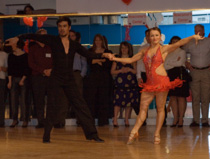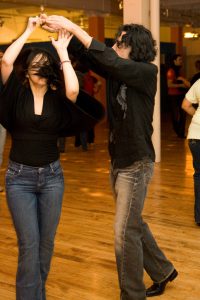Latin
Latin dance is a label that refers to a wide range of dances originating in Latin and Central America, the Caribbean and the United States.
Latin dances in competitions may refer to ‘International Style’ (Cha Cha, Rumba, Samba, Paso Doble, and Jive) or ‘American Rhythm’ (Cha Cha, Rumba, Swing, Bolero, Mambo). Social or Street Latin dances include salsa, mambo, merengue, bachata and the Argentine tango.
 Cha Cha
Cha Cha
An offshoot of the Mambo, this flirtatious and cheeky Latin dance is characterized by its syncopated cha-cha-cha in each measure, and is probably the most popular social Latin dance in America. It originated in the 1950’s as a slowed down Mambo, but is also a stepchild of the Swing. The Cha Cha was made famous by many Latin bands such as Xavier Cugat and Perez Prado, and today the Cha Cha rhythm is found in much of today’s popular music.
Merengue
Its simple small steps and characteristic hip swing, complete with graceful arm flourishes make this dance easy to learn and perfect for fast Latin music. The Merengue is a popular dance from Haiti and the Dominican Republic. So the story goes, there is an old tale about a famous military gentleman, General Maringie, who was wounded in battle and developed a limp. He got up to dance at a celebration in his honor, and danced dragging his injured leg. All the other men present, rather than embarrass him, danced in a similar way and thus was born the Merengue. Others say the Merengue was started as a peasant dance in the Dominican Republic by African slaves.

Rumba
The Rumba is Cuban in origin, and the music is a mixture of Latin and African rhythms. This was a street dance of courtship and marriage that met opposition from the upper classes because of the suggestive body and hip movements. Originally a lively, peppy dance, its current form is slow and sensual, giving you the chance to really express yourself, as well as to perfect technique, develop your sense of rhythm and muscle control that is also used in the faster Latin dances.
Salsa/Mambo
Salsa music is hot and so is the dance! With its tight, compact movements, Salsa is an exciting social dance and is one of the most popular club dances around today. Salsa is a more contemporary name for the same step pattern as Mambo, and came about when dancers started adding Hustle steps to Mambo.
Samba
The pulsing rhythm of the Samba and its fluid hip action make it one of the sexiest dances. When you hear the music, you’ll just have to learn this lively Brazilian dance. Known to Brazilians as their native dance, in was first introduced in 1917, but was finally adopted by Brazilian society in 1930. They say Carmen Miranda introduced the Samba in the United States in 1939. It is sometimes referred to as a Samba, Carioca, a Baion or a Batucado. The difference is mostly in the tempo played, since the steps in all these styles are very similar.
Bolero
Bolero is a romantic, sophisticated smooth and sentimental dance. Originally a Spanish dance, it was adapted in Cuba, and is known as the dance of love. The music and the feeling of Bolero enhance a sense of love and romance.
Cumbia
Cumbia is originally from Colombia. This is a fun dance that accentuates the swing of the hips in combination with a lot of arm movements.
Bachata
Bachata was born in the 1960’s and 1970’s in the Dominican Republic. It is danced to the slower, ballad-like Latin songs. Like Salsa, Bachata has an 8-count basic, but instead of moving back and forth like Salsa, Bachata moves from side to side. Additionally, partners tend to dance much closer to one another in Bachata. The basic is a side-together-side action and a hip roll and/or lift.
Paso Doble
The Paso Doble originates from Spain. It developed from movements performed by matadors during bullfights. The dance came into fashion around 1920. This is more of a performance/competition dance because it is based around previously agreed upon choreography (arranged precisely to the music) and it is far more difficult to improvise and lead. The character of the dance is arrogant and passionate.
NOBODY PUTS BABY IN THE CORNER!
Are you ready to make a move?
